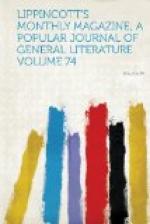It was accordingly arranged that on the following Sunday Anton should drive us to Reischach, where there was to be a great festival, with candles in the church as big as a man’s arm: so said a woman from Reischach. Anton was of a retiring nature, and did not like crowds, but he would gladly drive the ladies over. And at Reischach we should be sure to find some peasant returning that evening by Scharst, who could carry our belongings.
Imagine us, therefore, at Reischach, the church-bell ringing for vespers, which begin at one o’clock. We wear bouquets of carnations and rosemary, presented to us by the family at the Hof, as correct decorations for a festival. And Anton!—how to present him to you as he deserves to be presented? His truthful, guileless face is his best ornament: nevertheless, he too wears carnations and rosemary caught in the silver cord and vieing with the silver tassels of his broad-brimmed, low-crowned beaver hat. His rough jacket, made by the tailor last autumn, and therefore too new to be worn on a less special occasion, is short and loose enough to leave ample space for the display of his rauge, or broad leather belt of softest chamois-skin, worked in scrolls surrounding his name, with split peacock quills, no little resembling Indian handicraft. His snow-white knees appear between his short leather breeches and his bright blue knitted stockings. These Nature’s garters, when perfectly white, are regarded as a mark of great distinction amongst the dandies, and those of our Anton may be considered the very knee plus ultra.
A parliament of men—a few still in breeches with Hessian boots, which appeared a characteristic of Reischach, but the majority, having succumbed to modern ideas, wearing trowsers—were seated in the shadow of a comfortable house, discussing the different stages of their rye and flax crops. Their wives and daughters, following their natural impulse, were already kneeling in church, confiding their cares of kitchen and farmyard to the ever-ready ear of Mutter Gottes—one dense mass of simple, believing women, in broad-brimmed beaver hats, with here and there a conical woolen beehive as a contrast.
The church in itself, although it lacked the candles as big as a man’s arm, must truly have shone like the gate of heaven to peasant eyes. Many of the more substantial families had lent their private saints for the occasion. They had brought Holy Nothburgs and Saint Leonhards and Virgins, generally preserved in wardrobes at home, but now brought to participate in the festival, besides adding to its great solemnity. It was Scapulary Sunday, we were told, and although the words conveyed no clear idea to us, we were soon to learn their significance. A Tyrolese anthem having been sung by some invisible voices, in which jodels leapt up and smothered Gregorians, a middle-aged Capuchin took his stand in the pulpit, and having greeted the congregation, promised to explain to them the mystery and the advantage of the Holy Scapulary.




